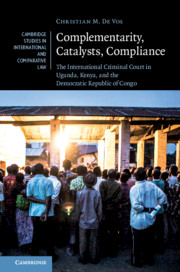 Complementarity, Catalysts, Compliance
Complementarity, Catalysts, Compliance from Part I - The ICC and Complementarity: Evolutions, Interpretations and Implementation
Published online by Cambridge University Press: 16 April 2020
This chapter offers a detailed review of the International Criminal Court’s (ICC’s) admissibility jurisprudence and argues that this body of case law largely requires states to mirror the same conduct (and even the same factual incidents) that the prosecutor investigates as a precondition for rendering a case inadmissible. While this approach is consistent with the coercive dimension of complementarity, it can also place a heavy burden on states, one that they may be unprepared (or unwilling) to meet. At the same time, the judicial treatment of Article 93(10), which provides the statutory basis for a ‘positive complementarity’ policy has been scant. Complementarity thus appears less as a space for constructive engagement and dialogue than a set of unifying criteria with which states must comply. While court officials and some commentators have defended the ICC’s approach, suggesting that it is technically consistent with the wording of Article 17, others have advocated a more flexible approach. The chapter thus illustrates the tension that arises between complementarity’s policy goals and the ICC’s more narrow, judicial remit. It further suggests that such tension is symptomatic of legalism: It relies on an artificial division between the court as a legal and political actor.
To save this book to your Kindle, first ensure [email protected] is added to your Approved Personal Document E-mail List under your Personal Document Settings on the Manage Your Content and Devices page of your Amazon account. Then enter the ‘name’ part of your Kindle email address below. Find out more about saving to your Kindle.
Note you can select to save to either the @free.kindle.com or @kindle.com variations. ‘@free.kindle.com’ emails are free but can only be saved to your device when it is connected to wi-fi. ‘@kindle.com’ emails can be delivered even when you are not connected to wi-fi, but note that service fees apply.
Find out more about the Kindle Personal Document Service.
To save content items to your account, please confirm that you agree to abide by our usage policies. If this is the first time you use this feature, you will be asked to authorise Cambridge Core to connect with your account. Find out more about saving content to Dropbox.
To save content items to your account, please confirm that you agree to abide by our usage policies. If this is the first time you use this feature, you will be asked to authorise Cambridge Core to connect with your account. Find out more about saving content to Google Drive.